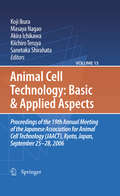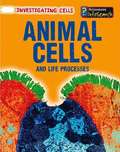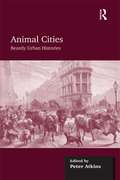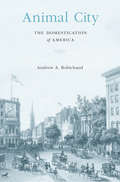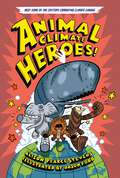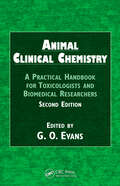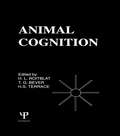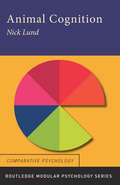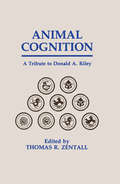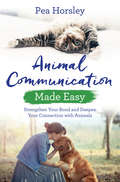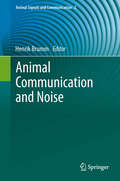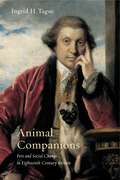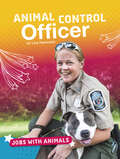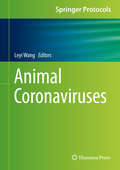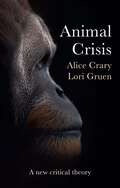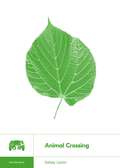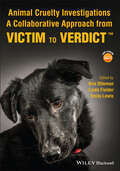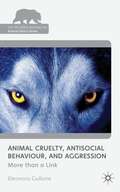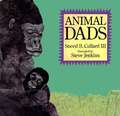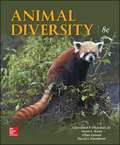- Table View
- List View
Animal Cell Technology: Proceedings of the 19th Annual Meeting of the Japanese Association for Animal Cell Technology (JAACT), Kyoto, Japan, September 25-28, 2006 (Animal Cell Technology: Basic & Applied Aspects #15)
by Koji Ikura Kiichiro Teruya Sanetaka Shirahata Masaya Nagao Akira IchikawaAnimal cell technology is a growing discipline of cell biology which aims not only to understand structures, functions and behaviors of differentiated animal cells, but also to ascertain their abilities to be used for industrial and medical purposes. The goal of animal cell technology includes the clonal expansion of differentiated cells, the optimization of their culture conditions, modulation of their ability to produce proteins of medical and pharmaceutical importantance, and the application of animal cells to gene therapy, artificial organs and the production of functional foods. This volume gives the readers a complete review of the present state-of-the-art and will be useful for those working in either academic environments or in the biotechnology and pharmaceutical sectors, particularly cell biologists, biochemists, molecular biologists, immunologists, biochemical engineers and all other disciplines related to animal cell culture.
Animal Cells And Life Processes (Investigating Cells)
by Megan Cotugno Barbara SomervillThis book explores the features of the animal cell and includes information about life processes such as respiration.
Animal Cities: Beastly Urban Histories
by Peter AtkinsAnimal Cities builds upon a recent surge of interest about animals in the urban context. Considering animals in urban settings is now a firmly established area of study and this book presents a number of valuable case studies that illustrate some of the perspectives that may be adopted. Having an ’urban history’ flavour, the book follows a fourfold agenda. First, the opening chapters look at working and productive animals that lived and died in nineteenth-century cities such as London, Edinburgh and Paris. The argument here is that their presence yields insights into evolving understandings of the category ’urban’ and what made a good city. Second, there is a consideration of nineteenth-century animal spectacles, which influenced contemporary interpretations of the urban experience. Third, the theme of contested animal spaces in the city is explored further with regard to backyard chickens in suburban Australia. Finally, there is discussion of the problem of the public companion animal and its role in changing attitudes to public space, illustrated with a chapter on dog-walking in Victorian and Edwardian London. Animal Cities makes a significant contribution to animal studies and is of interest to historical geographers, urban, cultural, social and economic historians and historians of policy and planning.
Animal City: The Domestication of America
by Andrew A. RobichaudAmerican urbanites once lived alongside livestock and beasts of burden. But as cities grew, human–animal relationships changed. The city became a place for pets, not slaughterhouses or working animals. Andrew Robichaud traces the far-reaching consequences of this shift—for urban landscapes, animal- and child-welfare laws, and environmental justice.
Animal Climate Heroes
by Alison Pearce StevensIn our left corner we have the meanest villain that’s ever existed. Responsible for rising seas and loss of biodiversity, it’s climate change ready to wreak havoc on the Earth. But in our right corner? We have four superheroes ready to save the day!Forest elephants protect our forests by trampling trees.Whales boost ocean health with their massive poo-nados.Sea otters defend kelp forests from purple invaders.And echidnas bury tons of soil to stop climate change.But we can’t leave them in this fight alone. We need to protect our heroes who, in return, defend our planet. Get ready to learn all about these four legged, and two-flippered, creatures and how YOU can be a climate hero too!
Animal Clinical Chemistry: A Practical Handbook for Toxicologists and Biomedical Researchers, Second Edition
by G. O. Evans10+ Years of Updates Since First EditionNewcomers to the animal clinical chemistry and toxicology fields quickly find that the same rules of human medicine do not always apply. Following in the footsteps of its standard-setting first edition, Animal Clinical Chemistry: A Practical Handbook for Toxicologists and Biomedical Researchers, Second Editio
Animal Cognition (Comparative Cognition and Neuroscience Series)
by H. L. Roitblat H. S. Terrace T. G. BeverFirst published in 1984. With this volume we initiate a series of books in comparative cognition and neuroscience. The presentations at the Harry Frank Guggenheim Conference, June 2-4, 1982, out of which the present volume grew, showed that this field of enquiry into cognitive functioning and its neural basis had reached maturity.
Animal Cognition (Routledge Modular Psychology)
by Nick LundAnimal Cognition looks at how non-human animals process information from their environment. Nick Lund has written an accessible and engaging account of this area of comparative psychology. The book contains chapters on animal navigation (including homing behaviour and migration), animal communication methods and research into animal language, and attempts to teach language to non-human animals. A chapter on memory includes models of memory in non-human animals and discusses the importance of memory in navigation and foraging behaviour.Animal Cognition is designed to cover the AQA(A) A2 level specification but will also be of interest to undergraduates new to comparative psychology. It is well illustrated and includes a study aids section with examination questions and answers, and key research summaries.
Animal Cognition: A Tribute To Donald A. Riley (Comparative Cognition and Neuroscience Series)
by Thomas R. ZentallPrepared as a tribute to Donald A. Riley, the essays that appear here are representative of a research area that has loosely been classified as animal cognition -- a categorization that reflects a functionalist philosophy that was prevalent in Riley's laboratory and that many of his students absorbed. According to this philosophy, it is acceptable to hypothesize that an animal might engage in complex processing of information, as long as one can operationalize evidence for such a process and the hypothesis can be presented in the context of testable predictions that can differentiate it from other mechanisms. The contributions to this volume represent the three most important areas of research in animal cognition -- stimulus representation, memory processes, and perceptual processes -- although current research has considerably blurred these distinctions.
Animal Communication
by Abbie DunneSimple text and bright photographs explain the concept of animal communication for beginning readers. The book concludes with a simple, kid-friendly activity.
Animal Communication Made Easy: Strengthen Your Bond and Deepen Your Connection with Animals
by Pea HorselyA practical and inspiring introductory guide to communicating with pets and wild animals.Your step-by-step guide to forming a deeper connection with animals.Do you love animals but wish you could understand what they're trying to tell you? Do some of their behaviours leave you baffled?In this book, world-renowned animal communicator Pea Horsley teaches you the essentials of animal communication to enable you to communicate intuitively with the animals you love. Pea leads you through grounding preparation processes to calm your body and release your mind, and then her effective five-step method to create a deep, spiritual connection with your animal.Drawing on her many years of experience teaching people to communicate with both wild and domesticated creatures, Pea's unique blend of exercises, affirmations and meditations will empower you to connect with all living beings.Communicating with animals is fun, profound and healing. It's the best thing you can do for both yourself and your animals, and will transform how you experience life.
Animal Communication Theory
by Ulrich E. StegmannThe explanation of animal communication by means of concepts like information, meaning and reference is one of the central foundational issues in animal behaviour studies. This book explores these issues, revolving around questions such as: • What is the nature of information? • What theoretical roles does information play in animal communication studies? • Is it justified to employ these concepts in order to explain animal communication? • What is the relation between animal signals and human language? The book approaches the topic from a variety of disciplinary perspectives, including ethology, animal cognition, theoretical biology and evolutionary biology, as well as philosophy of biology and mind. A comprehensive introduction familiarises non-specialists with the field and leads on to chapters ranging from philosophical and theoretical analyses to case studies involving primates, birds and insects. The resulting survey of new and established concepts and methodologies will guide future empirical and theoretical research.
Animal Communication and Noise (Animal Signals and Communication #2)
by Henrik BrummThe study of animal communication has led to significant progress in our general understanding of motor and sensory systems, evolution, and speciation. However, one often neglected aspect is that signal exchange in every modality is constrained by noise, be it in the transmission channel or in the nervous system. This book analyses whether and how animals can cope with such constraints, and explores the implications that noise has for our understanding of animal communication. It is written by leading biologists working on different taxa including insects, fish, amphibians, lizards, birds, and mammals. In addition to this broad taxonomic approach, the chapters also cover a wide array of research disciplines: from the mechanisms of signal production and perception, to the behavioural ecology of signalling, the evolution of animal communication, and conservation issues. This volume promotes the integration of the knowledge gained by the diverse approaches to the study of animal communication and, at the same time, highlights particularly interesting fields of current and future research.
Animal Companions: Pets and Social Change in Eighteenth-Century Britain (Animalibus)
by Ingrid H. TagueAnimal Companions explores how eighteenth-century British society perceived pets and the ways in which conversation about them reflected and shaped broader cultural debates.While Europeans kept pets long before the eighteenth century, many believed that doing so was at best frivolous and at worst downright dangerous. Ingrid Tague argues that for Britons of the eighteenth century, pets offered a unique way to articulate what it meant to be human and what society ought to look like. With the dawn of the Enlightenment and the end of the Malthusian cycle of dearth and famine that marked previous eras, England became the wealthiest nation in Europe, with a new understanding of religion, science, and non-European cultures and unprecedented access to consumer goods of all kinds. These transformations generated excitement and anxiety that were reflected in debates over the rights and wrongs of human-animal relationships.Drawing on a broad array of sources, including natural histories, periodicals, visual and material culture, and the testimony of pet owners themselves, Animal Companions shows how pets became both increasingly visible indicators of spreading prosperity and catalysts for debates about the morality of the radically different society emerging in eighteenth-century Britain.
Animal Companions: Pets and Social Change in Eighteenth-Century Britain (Animalibus: Of Animals and Cultures #6)
by Ingrid H. TagueAnimal Companions explores how eighteenth-century British society perceived pets and the ways in which conversation about them reflected and shaped broader cultural debates. While Europeans kept pets long before the eighteenth century, many believed that doing so was at best frivolous and at worst downright dangerous. Ingrid Tague argues that for Britons of the eighteenth century, pets offered a unique way to articulate what it meant to be human and what society ought to look like. With the dawn of the Enlightenment and the end of the Malthusian cycle of dearth and famine that marked previous eras, England became the wealthiest nation in Europe, with a new understanding of religion, science, and non-European cultures and unprecedented access to consumer goods of all kinds. These transformations generated excitement and anxiety that were reflected in debates over the rights and wrongs of human-animal relationships.Drawing on a broad array of sources, including natural histories, periodicals, visual and material culture, and the testimony of pet owners themselves, Animal Companions shows how pets became both increasingly visible indicators of spreading prosperity and catalysts for debates about the morality of the radically different society emerging in eighteenth-century Britain.
Animal Contests
by Ian C.W. Hardy Mark BriffaContests are an important aspect of the lives of diverse animals, from sea anemones competing for space on a rocky shore to fallow deer stags contending for access to females. Why do animals fight? What determines when fights stop and which contestant wins? Addressing fundamental questions on contest behaviour, this volume presents theoretical and empirical perspectives across a range of species. The historical development of contest research, the evolutionary theory of both dyadic and multiparty contests, and approaches to experimental design and data analysis are discussed in the first chapters. This is followed by reviews of research in key animal taxa, from the use of aerial displays and assessment rules in butterflies and the developmental biology of weapons in beetles, through to interstate warfare in humans. The final chapter considers future directions and applications of contest research, making this a comprehensive resource for both graduate students and researchers in the field.
Animal Control Officer (Jobs With Animals Ser.)
by Lisa HarkraderDo you love animals? Do you enjoy making sure animals and people are safe? Read this book to learn about becoming an animal control officer.
Animal Coronaviruses (Springer Protocols Handbooks)
by Leyi WangThis detailed volume provides diagnosticians and researchers with practical methodologies and approaches to tackle animal coronaviruses. It explores conventional immunohistochemistry, virus neutralization, enzyme-linked immunosorbent assays, expression and purification of recombinant viral proteins, and various molecular assays, including conventional and real-time reverse transcription-PCR, reverse genetics methodology, and next generation sequencing and sequence analyses. As part of the Springer Protocols Handbooks series, chapters contain readily reproducible laboratory protocols as well as expert tips on troubleshooting and avoiding known pitfalls. Practical and authoritative, Animal Coronaviruses serves as an ideal reference for researchers examining a wide variety of coronavirus species in the Coronaviridae.
Animal Coronaviruses (Springer Protocols Handbooks)
by Leyi WangThis detailed new edition compiles fully updated practical methodologies and approaches for diagnosticians and researchers working toward a better understanding of animal coronaviruses. The book explores vital techniques in virus isolation, diagnostic approaches via the detection of viral nucleic acids or proteins, serology, disease-targeted animal species models, and next-generation sequencing and bioinformatics. Written for the invaluable Springer Protocols Handbooks series, chapters contain readily reproducible laboratory protocols as well as expert tips on troubleshooting and avoiding known pitfalls. Thorough and hands-on, Animal Coronaviruses, Second Edition will help readers design and carry out their increasingly important projects in clinical research, diagnostics, disease surveillance, and epidemiological study involving this family of viruses.
Animal Crisis: A New Critical Theory
by Lori Gruen Alice CraryLeading philosophers Alice Crary and Lori Gruen offer a searing and desperately needed response to systems of thought and action that are failing animals and, ultimately, humans too. In the wake of global pandemics, mass extinctions, habitat destruction, and catastrophic climate change, they issue a clarion call to address the intertwined problems we face, arguing that we must radically reimagine our relationships with other animals. In stark contrast to traditional theories in animal ethics, which abstract from social mechanisms harmful to human beings, Animal Crisis makes the case that there can be no animal liberation without human emancipation. Borrowing from critical theories such as ecofeminism, Crary and Gruen present a critical animal theory for understanding and combating the structural forces that enable the diminishment of so many to the advantage of a few. With seven case studies of complex human-animal relations, they make an urgent plea to dismantle the “human supremacism” that is devastating animal lives and hurtling us toward ecocide.
Animal Crossing (Boss Fight Books)
by Kelsey LewinBefore the world of Animal Crossing became a pandemic lifeline for millions, the &“social sim&” communication game D??butsu no Mori, or &“Animal Forest,&” debuted in 2001 on Nintendo 64 in Japan, then once again in 2002 on GameCube to critical and commercial success all over the world. An open-ended casual game ahead of its time, Animal Crossing set the stage for the series&’s many incarnations to come with its focus on building community and friendship, its in-game currency of Bells, and its village of Animalese-speaking friends like Tom Nook, K.K. Slider, and the mean Mr. Resetti. You could visit the villages of your friends and give them gifts—all without being connected to the internet. Video game preservationist and historian Kelsey Lewin tells the story of how a mundane-sounding game full of bug-catching, letter-writing, and furniture-collecting became one of Nintendo&’s best-loved franchises, with Animal Crossing: New Horizons eclipsing Super Mario Bros. for all-time sales in Japan, unlocking gaming&’s massive potential to tap into our desire to plant trees, find friends, and make the world a better place.
Animal Cruelty Investigations: A Collaborative Approach from Victim to Verdict
by Linda Fielder Emily Lewis Kris OttemanAnimal Cruelty Investigations: A Collaborative Approach from Victim to Verdict provides a framework for the experts who respond to animal cruelty cases: veterinarians, law enforcement agencies, animal care and control organizations, and prosecutors. This book is a practical guide which provides insight and direction for every phase of an animal cruelty investigation. The step-by-step guidance on responding to particular issues and challenges related to animal cruelty cases is bolstered by the extensive library of checklists, form templates, specific case protocols, and lists of available resources. This book is designed to empower readers to respond to animal cruelty cases confidently and effectively by: Introducing veterinarians to their critical role in animal cruelty investigations including forensic examination and necropsy, crime scene response, report writing, and testimony. Included are detailed Specific Case Protocols for common animal cruelty scenarios. Helping animal shelters navigate the challenges of holding animals in protective custody, housing unusual species, and placing evidence animals in foster care. Offering law enforcement agencies useful methods for investigating animal cruelty such as search and seizure protocols, witness interview techniques, and valuable forms and templates necessary to strengthen and ensure proper search warrant execution, evidence collection and handling, and chain of custody; all with a focus on animals as both victims and evidence. Guiding prosecutors through the steps necessary to utilize the veterinarian’s findings during trial and providing insight into issues to be considered when reviewing search warrants, filing charges, proposing plea agreements, or filing pre-conviction forfeiture motions. This book is a must-have reference and guide for veterinarians, technicians, law enforcement officers, prosecutors, and all those involved in the protection of animals’ health and wellbeing. The successful investigation of animal crimes relies on each of these disciplines, not only carrying out their professional duties, but having a collective understanding of what each other needs in order to meet that expectation.
Animal Cruelty, Antisocial Behaviour and Aggression
by Eleonora GulloneDemonstrating that animal cruelty behaviours are another form of antisocial behaviour, alongside human aggression and violence, and almost without exception are carried out by the same individuals this book offers clear recommendations for future research on animal cruelty and future action aimed at prevention.
Animal Dads
by Sneed B. Collard IIIA good book for children describing many types of animals and how their dads play a part of their lives, including the seahorse who actually gives birth to the little seahorse babies.
Animal Diversity
by Allan Larson Susan Keen Cleveland Hickman David Eisenhour Larry RobertsThis text provides a concise introduction to the field of animalbiology. Readers discover general principles of evolution, ecology, animal bodyplans, and classification and systematics. After these introductory chapters,readers delve into the biology of all groups of animals. The basic features ofeach group are discussed, along with evolutionary relationships among groupmembers. Chapter highlights include newly discovered features of animals asthey relate to ecology, conservation biology, and value to human society.Regular updates to the phylogenies within the book keep it current.
